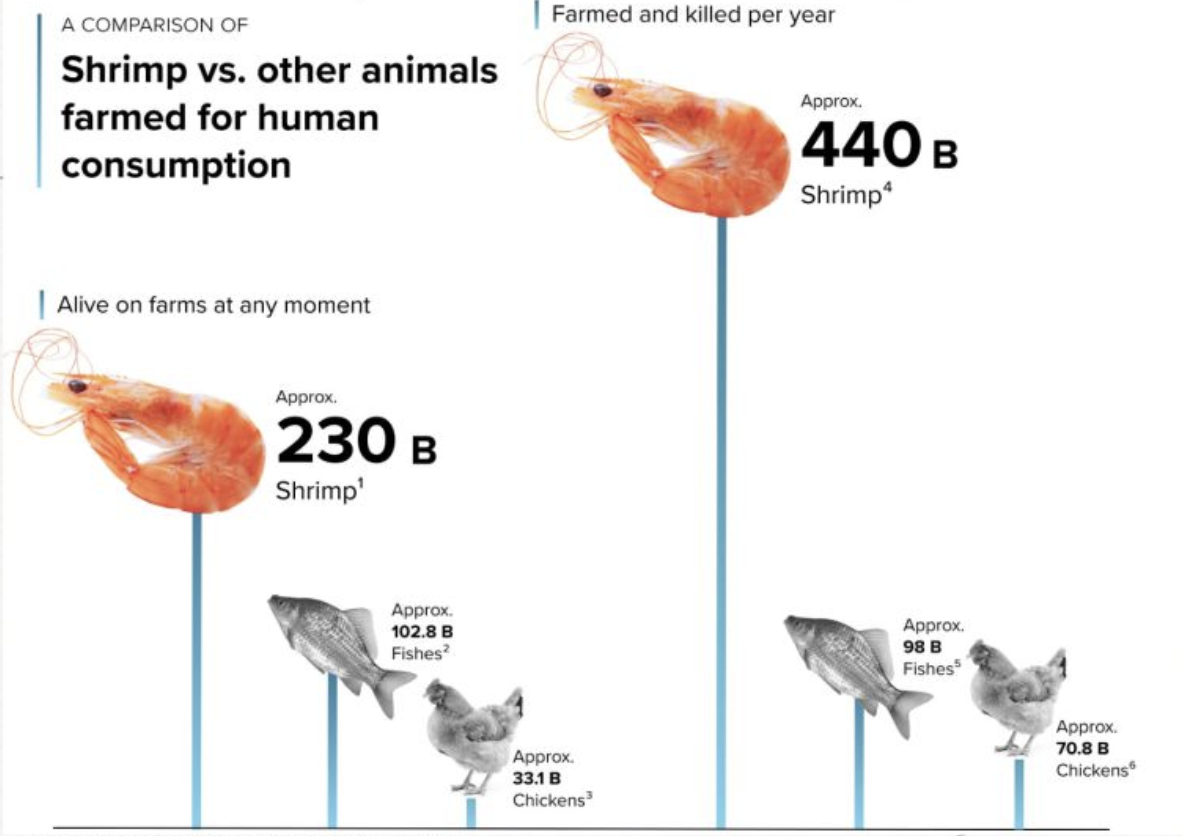Do Shrimps Feel Pain?
Shrimps are one of the most commonly consumed foods in the world, but as public awareness of animal welfare grows, a crucial question emerges: Can shrimps feel pain? Understanding whether shrimps are sentient impacts how we treat these creatures but also influences fishing practices, culinary decisions, and animal welfare laws.
Why Does Shrimp Welfare Matter?
Unlike land animals raised for consumption, shrimps have received relatively little scientific research, public attention, or legal protection. Despite being killed in vastly greater numbers — hundreds of billions annually — they are frequently excluded from animal welfare legislation and ethical discussions.
This neglect is not due to lack of impact but rather due to invisibility. Shrimps are small, silent, and alien in appearance. Their unfamiliar biology and lack of facial expressions lead many to assume they are too simple to suffer. But this assumption is being challenged by emerging science.
As a result of this oversight, shrimps are routinely subjected to farming and slaughter practices that would be considered cruel or unacceptable for other animals: being boiled alive, transported in dry conditions, or killed without stunning. Their suffering often goes unnoticed — not because it doesn’t exist, but because we have not been taught to look for it.
Shrimp estimates visualization by Rethink Priorities
What Does The Research Say About Shrimp Sentience?
Recent studies suggest that shrimps are far more complex than we once believed. There is growing behavioral and neurological evidence indicating that shrimps can feel pain — real, subjective pain — not just mechanical, reflexive responses.
Key Findings:
Presence of Nociceptors - Shrimps have been found to possess nociceptors, specialized nerve cells that detect potentially harmful stimuli. While the presence of nociceptors alone doesn’t confirm conscious pain, it is a necessary biological foundation for it.
Complex Nervous System - Although shrimps have a very different nervous system from mammals, it is still capable of transmitting and processing complex signals. This includes centralized ganglia that could play a role in integrating sensory input into behavioral responses.
Protective and Self-Directed Behavior - When exposed to painful stimuli — such as noxious chemicals or eyestalk ablation — shrimps have been observed grooming or rubbing the affected area. This targeted, prolonged behavior suggests discomfort and an attempt to alleviate it, rather than a mere reflex.
Avoidance Learning - In several experiments, shrimps learned to avoid areas where they were previously harmed. This type of learning — known as associative or avoidance learning — is a key behavioral indicator of sentience and conscious experience of pain.
Do Animal Welfare Laws Protect Shrimps?
The implications of these findings are significant, particularly given the scale of shrimp farming and harvesting. A growing number of scientists and policymakers are beginning to take notice.
In 2021, the UK government officially recognized decapod crustaceans, including shrimps, as sentient beings under the Animal Welfare (Sentience) Act. This decision followed an extensive review by the London School of Economics, which concluded that there was strong evidence of sentience in crustaceans and cephalopods.
Other nations are also taking steps forward:
Austria, Switzerland, and Norway have incorporated protections for decapods within their animal welfare frameworks.
These changes reflect a growing global consensus: shrimps are not mere biological machines. They are sentient beings capable of suffering, and they deserve consideration in our ethical and legal systems.
Are There Better Ways to Farm Shrimps Humanely?
As awareness of shrimp sentience grows, so too does interest in improving their treatment. While shrimp welfare is still in its early stages compared to land animals, a number of organizations, researchers, and producers are beginning to explore more ethical alternatives.
Developments in Farmed Shrimp Welfare:
Stunning Before Slaughter
Traditional slaughter methods often involve boiling shrimps alive or letting them suffocate in air. However, electrical stunning is being studied and introduced as a more humane method to render shrimps unconscious before death. This practice could drastically reduce suffering in the shrimp farming industry, and Shrimp Welfare Project works with producers to promote the adoption of electrical stunning technology.Better Transport and Handling
Shrimps are often transported in high densities without water, leading to extreme stress and high mortality. Efforts are being made to develop transport systems that allow shrimps to be transported in water, maintain good water quality, reduce crowding, and minimize injury during handling.Improved Water Quality and Environmental Enrichment
Welfare isn't just about how animals die — it’s also about how they live. Some shrimp farms are experimenting with cleaner, more spacious tanks, oxygenation systems, and even low-light environments to reduce stress. While environmental enrichment for shrimps is still being explored, early research suggests they respond positively to more complex surroundings.
Final Thoughts: Can Shrimps Feel Pain?
While we may never fully grasp what it feels like to be a shrimp, the evidence points to an important truth: these creatures are not indifferent to harm. They experience discomfort, exhibit learning behaviors, and respond in ways consistent with pain and distress.
Recognizing this challenges us to expand our circle of compassion. If we care about reducing suffering, we must care not only for the animals that are easy to empathize with — but also for the quiet, overlooked ones beneath the surface.
To read more about the science on shrimp sentience, check out our in-depth research review.

